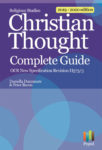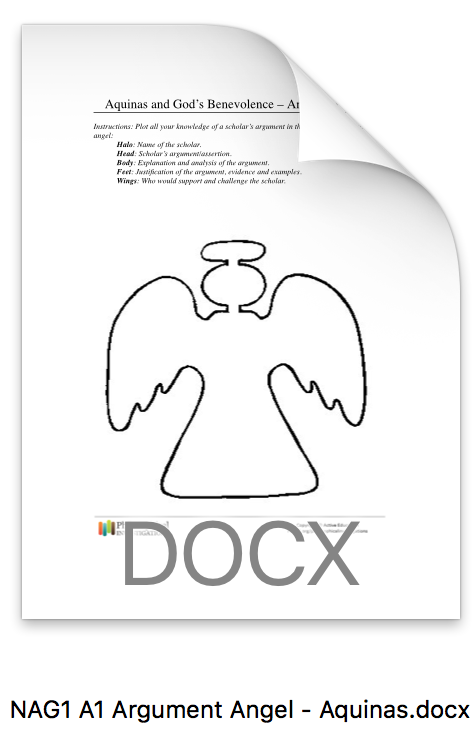or
H573 Teaching Pack Philosophy of Religion Complete Course
Author: Andrew Capone
Product Format: Digital documents
Content covers the nature and attributes of God (including discussion of Anselm, Boethius and Swinburne) religious language (negative, analogical and symbolic) and twentieth century perspectives on Philosophy of Religion from Wittgenstein, Ayer, Hare, Flew and Mitchell. Lesson Plans, powerpoints, extracts and starter activities are all included to give a multiple intelligences approach to teaching Philosophy of Religion.
£55.99
What’s inside the pack?
This pack contains: 345 Word Docs & 33 PowerPoints:
File list: (note: all files are Word Docs unless otherwise stated)
Example Pages
Teaching Pack Contents
POR 1 Philosophical Language and Thought
Lesson 1 – Allegory of the Cave
- PLT1 A1 Argument Temple – Knowledge
- PLT1 A2 Key Points FORMs
- PLT1 A3 Taboo – Plato Cave
- PLT1 E1 Source – Allegory of the Cave
- PLT1 L Lesson Planning – Allegory of the Cave
- PLT1 P Allegory of the Cave – pptx
Lesson 2 – Theory of Forms
- PLT2 A1 Key Terms – Plato FORMs
- PLT2 A2 Mind Mapping – Plato Cave
- PLT2 A3 Plenary Triangle – Plato FORMs
- PLT2 E1 Source – Plato FORMs
- PLT2 L Lesson Planning – Theory of FORMs
- PLT2 P Theory of FORMs – pptx
Lesson 3 – Four Causes
- PLT3 A1 Diamond 9 – Aristotle
- PLT3 A2 Argument Analysis – Four Causes
- PLT3 A3 Dominoes – Plato and Aristotle
- PLT3 E1 Source – Four Causes
- PLT3 L Lesson Planning – Aristotles Four Causes
- PLT3 P Four Causes – pptx
Lesson 4 – Plato v Aristotle
- PLT4 A1 Sorting Task – Plato Aristotle
- PLT4 A2 Revision Pamphlet
- PLT4 A3 Taboo – Plato Aristotle
- PLT4 L Lesson Planning – Plato v Aristotle
- PLT4 P Plato v Aristotle – pptx
Lesson 5 – Platonic Dualism
- PLT5 A1 Venn Diagram – Plato and Aristotle
- PLT5 A2 Knowledge Wheel – Dualism
- PLT5 A3 Triangulation – Dualism
- PLT5 E1 Source – Dualism
- PLT5 E2 Source – Myth of Er
- PLT5 L Lesson Planning – Platonic Dualism
- PLT5 P Platonic Dualism – pptx
Lesson 6 – Aristotelian Monism
- PLT6 A1 Venn Diagram – Dualism and Monism
- PLT6 A2 Scholar Dialogue – Dualism Monism
- PLT6 A3 Taboo – Monism and Dualism
- PLT6 E1 Source – Monism
- PLT6 L Lesson Planning – Aristotelian Monism
- PLT6 P Aristotelian Monism – pptx
Lesson 7 – Substance Dualism
- PLT7 A1 Key Terms – Substance Dualism
- PLT7 A2 Silent Debate – Substance Dualism
- PLT7 A3 Three Questions – Substance Dualism
- PLT7 E1 Source – Descartes
- PLT7 L Lesson Planning – Substance Dualism
- PLT7 P Substance Dualism – pptx
Lesson 8 – Materialism
- PLT8 A1 Diamond 9 – Materialism
- PLT8 A2 De Bono Hats – Dawkins
- PLT8 A3 Dominoes – Materialism
- PLT8 E1 John Locke
- PLT8 E2 Bertrand Russell
- PLT8 E3 Richard Dawkins
- PLT8 L Lesson Planning – Materialism
- PLT8 P Materialism – pptx
POR 2 Arguments for the Existence of God
Lesson 1 – Cosmological Argument
- AEG1 A1 Sorting Task – Three Ways
- AEG1 A2 Argument Analysis – Cosmological
- AEG1 A3 Plenary Triangle
- AEG1 E1 Source – Aquinas
- AEG1 E2 Source – Copleston Russell
- AEG1 L Lesson Planning – Cosmological Argument
- AEG1 P Cosmological Argument – pptx
Lesson 2 – Cosmological Argument Challenges
- AEG2 A1 Scholar Comparison – Contingency
- AEG2 A2 Key Points – Cosmological Challenges
- AEG2 A3 Three Questions
- AEG2 E1 Source – Hume
- AEG2 L Challenges to the Cosmological Argument
- AEG2 P Cosmological Challenges – pptx
Lesson 3 – Teleological Argument
- AEG3 A1 Sorting Task – Paley Watch
- AEG3 A2 Mind Mapping – Teleological
- AEG3 A3 Dominoes – Arguments
- AEG3 E1 Source – Aquinas
- AEG3 E2 Source – Paley
- AEG3 E2 Source – Swinburne
- AEG3 L Lesson Planning – Teleological Argument
- AEG3 P Teleological Argument – pptx
Lesson 4 – Teleological Argument Challenges
- AEG4 A1 Venn Diagram – Teleological
- AEG4 A2 De Bono Hats – Mill
- AEG4 A3 Taboo – Teleological
- AEG4 E1 Source – Hume
- AEG4 E2 Source – Vardy
- AEG4 E3 Source – Mill
- AEG4 L Challenges to the Teleological Argument
- AEG4 P Teleological Challenges – pptx
Lesson 5 – Ontological Argument
- AEG5 A1 Key Terms – Ontological
- AEG5 A2 Knowledge Wheel – Ontological
- AEG5 A3 Confused Opinions – Ontological
- AEG5 E1 Source – Anselm
- AEG5 L Lesson Planning – Ontological Argument
- AEG5 P Ontological Argument
Lesson 6 – Ontological Argument Challenges
- AEG6 A1 Diamond 9 – Arguments from Reason
- AEG6 A2 Scholar Dialogue – Anselm Gaunilo
- AEG6 A3 Dominos – Ontological
- AEG6 E1 Source – Gaunilo
- AEG6 E2 Source – Aquinas
- AEG6 E3 Source – Russell
- AEG6 L Challenges to the Ontological Argument
- AEG6 P Ontological C
- hallenges – pptx
POR 3 God and the World
Lesson 1 – Nature of Religious Experience
- GTW1 A1 Diamond 9 – Religious Experience
- GTW1 A2 Key Points – Religious Experience
- GTW1 A3 Taboo – Religious Experience
- GTW1 E1 Source – Joseph Dreams
- GTW1 E2 Source – Moses Burning Bush
- GTW1 E3 Source – Conversion of Saul
- GTW1 E4 Source – Bernadette of Lourdes
- GTW1 E5 Source – Our Lady of Fatima
- GTW1 E6 Source – Teresa of Avila
- GTW1 E7 Source – Richard Swinburne
- GTW1 L Lesson Planning – Nature of Religious Experiences
- GTW1 P The Nature of Religious Experience – pptx
Lesson 2 – William James on Religious Experience
- GTW2 A1 Sorting Task – William James
- GTW2 A2 Knowledge Wheel – William James
- GTW2 A3 Triangulation – Religious Experience
- GTW2 E1 Source – William James
- GTW2 E2 Source – William James
- GTW2 L Lesson Planning – William James
- GTW2 P William James – pptx
Lesson 3 – Psychological Challenge
- GTW3 A1 Argument Temple – Psychological
- GTW3 A2 Argument Analysis – Psychological
- GTW3 A3 Bloom Cube – Psychological
- GTW3 E1 Source – Sigmund Freud
- GTW3 E2 Source – Huston Smith
- GTW3 L Lesson Planning – Psychological Challenge
- GTW3 P The Psychological Challenge – pptx
Lesson 4 – Physiological and Sociological
- GTW4 A1 Key Terms – Religious Experience
- GTW4 A2 Silent Debate – Physiological Sociological
- GTW4 A3 Dominoes – Challenges
- GTW4 D1 Scientific Responses
- GTW4 E1 Source – Max Weber
- GTW4 E2 Source – Karl Marx
- GTW4 L Lesson Planning – Physiological and Sociological Challenges
- GTW4 P The Physiological and Sociological Challenges – pptx
Lesson 5 – The Problem of Evil
- GTW5 A1 Diamond 9 – Problem of Evil
- GTW5 A2 Silent Debate – Evil
- GTW5 A3 Taboo – Problem of Evil
- GTW5 D1 The Problem of Evil
- GTW5 E2 Source – John Stuart Mill
- GTW5 L Lesson Planning – The Problem of Evil
- GTW5 P The Problem of Evil – pptx
Lesson 6 – Augustine Theodicy
- GTW6 A1 Key Terms – Problem of Evil
- GTW6 A2 De Bono Hats – Augustine
- GTW6 A3 Plenary Triangle – Augustine
- GTW6 E1 Source – Augustine
- GTW6 E1 Source – Book of Job
- GTW6 L Lesson Planning – Augustine Theodicy
- GTW6 P Augustine Theodicy – pptx
Lesson 7 – Irenaeus Theodicy
- GTW7 A1 Question Analysis – Augustine
- GTW7 A2 Scholar Dialogue – Augustine Irenaeus
- GTW7 A3 Dominoes – Theodicies
- GTW7 D1 Hick Theodicy
- GTW7 L Lesson Planning – Irenaeus Theodicy
- GTW7 P Irenaeus Theodicy – pptx
Lesson 8 – Challenges to the Theodicies
- GTW8 A1 Argument Angel – Theodicy
- GTW8 A2 Mind Mapping – Challenges
- GTW8 A3 Three Questions – Challenges
- GTW8 D2 Challenge to the Theodicies
- GTW8 L Lesson Planning – Challenges to the Theodicies
- GTW8 P Challenges to the theodicies – pptx
4 NAG Nature and Attributes of God (folder)
Lesson 1 – Omnipotence
- NAG O Nature and Attributes of God
- NAG1 A1 Argument Angel – Aquinas
- NAG1 A1 Diamond 9 – Omnipotence
- NAG1 A2 Argument Analysis – Aquinas
- NAG1 A2 Mind Mapping
- NAG1 A3 Bloom Cube – Omnipotence
- NAG1 A3 Plenary Triangle
- NAG1 E1 Source – Biblical Accounts
- NAG1 E2 Source – Aquinas
- NAG1 E3 Source – Descartes
- NAG1 L Omnipotence
- NAG1 P Omnipotence pptx
Lesson 2 – Benevolence
- NAG2 A1 Sorting – Decalogue
- NAG2 A1 Venn Diagram – Characteristics
- NAG2 A2 Key Points – Jesus
- NAG2 A2 Silent Debate – Goodness of God
- NAG2 A3 Image Assignment – Euthpyphro
- NAG2 A3 Triangulation – Nature of God
- NAG2 E1 Source – Biblical Extracts
- NAG2 E2 Source – Richard Swinburne
- NAG2 E3 Source – Kant and Jerome
- NAG2 L Benevolence
- NAG2 P Benevolence pptx
Lesson 3 – Omniscience
- NAG3 A1 Argument Temple – Nature of God
- NAG3 A2 Revision Pamphlet – Nature of God
- NAG3 A3 Dominos – Nature of God
- NAG3 A3 Three Questions – Omniscience
- NAG3 E1 Source – Biblical Extracts
- NAG3 E2 Source – Louis of Molina
- NAG3 E3 Source – Richard Dawkins
- NAG3 L Omniscience
- NAG3 P Omniscience pptx
- NAG3.A1 Scholar Comparison
- NAG3.A2 Knowledge Wheel – Omniscience
Lesson 4 – Eternity
- NAG4 A1 Key Terms – Nature of God
- NAG4 A1 Question Analysis – Eternity
- NAG4 A2 De Bono Hats – Boethius
- NAG4 A2 Scholar Dialogue – Boethius and Lady Philosophy
- NAG4 A3 Confused Opinions – Eternity
- NAG4 A3 Taboo – Nature of God
- NAG4 D1 Summary – Boethius
- NAG4 E1 Source – Biblical Accounts
- NAG4 E2 Source – Greek Accounts
- NAG4 E3 Source – Augustine
- NAG4 E4 Source – Boethius
- NAG4 E5 Source – Aquinas
- NAG4 E6 Source – Swinburne
- NAG4 E7 Source – Swinburne
- NAG4 E8 Source – Davies
- NAG4 L Eternity
- NAG4 P Eternity pptx
5 Religious Language Classical
RLC.O Classical Religious Language
Lesson 1 – Via Negativa
- RLC1 A1 Diamond 9 – Via Negativa
- RLC1 A1 Key Terms – Religious Language
- RLC1 A2 Argument Analysis – Via Negativa
- RLC1 A2 De Bono Hats – Maimonides
- RLC1 A3 Confused Opinions – Via Negativa
- RLC1 A3 Plenary Triangle – Via Negativa
- RLC1 E1 Source – Moses Maimonides
- RLC1 L Apophatic Way
- RLC1 P Via Negativa
Lesson 2 – Analogy
- RLC2 A1 Argument Angel – Via Negativa
- RLC2 A1 Question Analysis – Via Negativa
- RLC2 A2 Key Points Table – Analogy
- RLC2 A2 Mind Mapping – Analogy
- RLC2 A3 Bloom Cube – Analogy
- RLC2 A3 Image Assigning – Baker
- RLC2 E1 Source – Aquinas
- RLC2 L Cataphatic Way
- RLC2 P Analogy
Lesson 3 – Symbol
- RLC3 A1 Scholar Comparison – Maimonides and Aquinas
- RLC3 A1 Venn Diagram – Positive and Negative language
- RLC3 A2 Knowledge Wheel – Symbols
- RLC3 A2 Revision Pamphlet – Religious Language
- RLC3 A3 Dominoes – Religious Language
- RLC3 A3 Triangulation – Religious Language
- RLC3 E1 Source – Tillich
- RLC3 L Symbols
- RLC3 P Symbols pptx
6 Religious Language Logical Positivism
Lesson 1 – Logical Positivism
- RLL1 A1 Argument Temple Logical Positivism
- RLL1 A1 Diamond 9 – Logical Positivism
- RLL1 A2 De Bono Hats – Orwell
- RLL1 A2 Silent Debate – Verificationism
- RLL1 A3 Image Assigning – Raven
- RLL1 A3 Three Questions – Verification
- RLL1 D1 Summary – Verification
- RLL1 E1 Source – Ayer
- RLL1 E2 Source – Orwell Newspeak
- RLL1 L Verification
- RLL1 P Verification pptx
Lesson 2 – Verification
- RLL2 A1 Argument Angel – Verification
- RLL2 A1 Question Analysis – Verification
- RLL2 A2 Revision Pamphlet – Verificationism
- RLL2 A2 Scholar Dialogue – Wittgenstein Ayer
- RLL2 A3 Bloom Cube – Language Games
- RLL2 A3 Plenary Triangle – Verification
- RLL2 E1 Source – Flew
- RLL2 E2 Source – Wittgenstien
- RLL2 E3 Source – Swinburne
- RLL2 L Language Games
- RLL2 P Language Games pptx
Lesson 3 – Falsification
- RLL3 A1 Key Terms – Logical Positivism
- RLL3 A1 Scholar Comparison – Verification
- RLL3 A2 Key Points Table – Falsification
- RLL3 A2 Mind Mapping – Falsification
- RLL3 A3 Confused Opinions – Falsification
- RLL3 A3 Triangulation – Logical Positivism
- RLL3 D Summary – Falsification
- RLL3 E1 Source – Popper
- RLL3 E2 Source – Flew
- RLL3 L Falsification
- RLL3 P Falsification pptx
Lesson 4 – Bliks
- RLL4 A1 Sorting Task – Falsification Parables
- RLL4 A1 Venn Diagram – Religious Language
- RLL4 A2 Argument Analysis – Bliks
- RLL4 A2 Knowledge Wheel – Parables
- RLL4 A3 Dominoes – Religious Language
- RLL4 A3 Taboo – Logical Positivism
- RLL4 D1 Summary – Response to Flew
- RLL4 E1 Source – Hare
- RLL4 L Bliks
- RLL4 P Bliks pptx

















